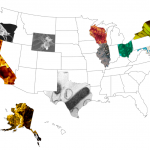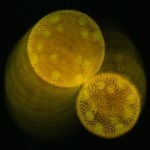microbes
I am very excited about the upcoming 3rd annual Michigan Physiological Society Meeting on May 12-13 in Detroit. This society is a local chapter of the American Physiological Society. I am most excited by their choice of a Comparative Physiologist for the keynote address: Dr. Hannah V. Carey from the University of Wisconsin School of Veterinary Medicine. Dr. Carey is a Past-President of the American Physiological Society. She will be presenting her research on how the gut microbiome of hibernators changes seasonally as well as the symbiotic relationship between the gut microbes and the…
By Hollingsworth John and Karen, U.S. Fish and Wildlife Service [Public domain], via Wikimedia Commons
Researchers are spending a lot of time exploring how the microbes living in our guts impact our health. In a new study published in Cell Reports, researchers wanted to know how the gut microbes of wild brown bears changes between summer and hibernation. They discovered that during the summer, the microbial species present in the gut are more diverse and are of the type that helps store energy. In fact, when the research team gave the microbes to rodents, the rodents gained…
Image from the American Physiological Society's website.http://www.the-aps.org/mm/Conferences/APS-Conferences/2014-Conferences/…
Tuesday was no less exciting than Monday!
Here are some highlights:
I thoroughly enjoyed a session called "Overcoming a Major Physiological Barrier: Adaptation from Saline to Freshwater Habitats" which highlighted the need for several species to shift how they regulate ion balance when they migrate between fresh water (ion absorption from the water) and salt water (ion secretion to the water).
Clements K, Bojarski L, Johnson K, McMillan S, White L, Angert E (Univ…
I am very excited about the upcoming Experimental Biology conference that starts next weekend. I just looked through the Spring newsletter for the Comparative and Evolutionary Physiology section of the American Physiological Society. Check out the exciting programming in comparative physiology at this year's conference:
Monday, April 28
10:30 AM – 12:30 PM
Featured Topic: Abstract-Driven Trainee Session
3:15 PM – 5:15 PM
Featured Topic: Comparative Physiology of Aging and Senescence
Tuesday, April 29
8:00 AM – 10:00 AM
CEPS Symposium: RNAseq Approaches to…
I found some slightly mouldy bread in the cupboard, cut off the mould and made toast. And I thought about bread and microbes.
For flavour, not as a raising agent, I make sour dough. My method is simple: I mix rye flour with water in a glass, cover it with cling film and put it on the countertop for a week or so. Lactic acid bacteria soon colonise the mix, lowering the pH to make the environment cosy for themselves and deter any other opportunistic microbes.
When the sour dough smells like vinegar I make bread dough with it, adding a second microbe: yeast fungus. The yeast eats sugar in the…
Roberto Kolter, Professor of Microbiology and Molecular Genetics at Harvard's
Medical School, believes that microbes, bacteria in particular, have gotten a bad
rap. "Oh sure, occasionally a nasty one like Salmonella or E. coli gets through
and causes trouble," he says, "but for the most part bacteria are quite beneficial,
helping us to digest our food, for example, and aiding in the maintenance of the
ecology."
Microbes are also ubiquitous - living practically everywhere - but for the most
part, scientists still know little about them, Roberto adds. To illustrate this point,
Roberto likes to…
Watch a little about Microbes from the Fall 2010 USA Science and Engineering Festival.
The average science student knows that microbiology is the study of bacteria and other microorganisms, especially those that cause disease and other threats to health.
But what the public often does not realize is that the work of the microbiologist is growing ever more important today as such microorganisms are linked at an alarming rate to outbreaks of new infectious disease and food poisoning caused by bacteria such as Salmonella and E. coli, in addition to the growing difficulty in treating…
The Harvard Microbial Sciences Initiative Graduate Consortium hosted a fun workshop during the January term where students learned about microscopy by taking some amazing pictures of food microbes. The images taken with the scanning electron microscope of sauerkraut, kombucha, and some stinky cheeses show beautiful and complex landscapes made by and of microbes.
Sauerkraut is fermented by cute rod-shaped lactic acid bacteria:
Kombucha, a tea fermented by a combination of yeasts and bacteria, looks incredible under the microscope, where you can see the dense mesh of cellulose fibers that the…
Student guest post by Liz Stepniak
In the United States, the obesity epidemic is rapidly spreading. Since 1980 the prevalence of obesity has increased over 75%. Currently, over half the population is overweight, and nearly 1 in every 3 adults is clinically obese. Research has also been proliferating, exploring a plethora of possibilities to better understand and treat this growing epidemic. One of the recent trends in obesity research has been investigating the role of the microbiota in the gut and differences in the composition of these bacteria between obese and non-obese individuals.…
I've had some great suggestions for "Official" State Microbes in comments and via twitter. I'm filling in the map as they come:
So far we have:
Alaska -- Alcanivorax borkumensis for its oil consumption
California -- Ralstonia metallidurans for its gold precipitating qualities (and CA-MRSA as a terrifying runner up)
Illinois -- Penicillium roqueforti for its blue cheese making
Maryland -- Chlamydia trachomatis for UMD research on the bug
Massachusetts -- Escherichia coli for its importance to biotech
New York -- Pseudomonas putida, the first organism to be the subject of a patent case, which…
tags: biodiversity, conservation, endangered species, Encyclopedia of Life, TEDTalks, E.O. Wilson, streaming video
As E.O. Wilson accepts his 2007 TEDTalks Prize, he makes a plea on behalf of all creatures that we learn more about our biosphere -- and build a networked encyclopedia of all the world's knowledge about life [24:22]
TEDTalks is a daily video podcast of the best talks and performances from the TED Conference, where the world's leading thinkers and doers are invited to give the talk of their lives in 18 minutes.
by Katie the Lowly Intern
Researchers at Cambridge University have debunked the long standing myth that freshwater algae can't dance. Volvox, while sounding like a herpes medication for mad scientists, is a spherical algae organism made up of only about 1,000 cells. They get their swerve from their flagella (think sperm tails) which they wag around until they create a flow of fluid. This flow of fluid causes them to stay in bound movements with each other; one movement being called a "waltz" and the other a "minuet." Scientists think that the oscillating dance moves make it easier for the…
As apex organisms in the scope of Earth's multi-tiered web of life, most of us go about our day-to-day activities oblivious to the fact that bacteria are literally everywhere. Microorganisms can thrive in the most surprising locales—places totally inhospitable to human life. Recently, scientists from Harvard documented a flourishing bacterial ecosystem buried under 400 meters of ancient glacial ice; more common bacteria, Salmonella may lurk on your dinner plate, as a report citing 48,600 infections across ten states in 2008 attests; and if it's any indication from this scientific pursuit,…
ThinkGeek has a phenomenal new product line just in time for the holidays: Plush Microbes!
There are a ton of them, but below are some of my favorites:
There are also a ton of owner submitted action shots, documenting the fun that can be had with your microbes!
Nature isn't cruel, just indifferent
Tomato scare!
Easter egg hunting is more fun with Salmonella!
Thanks once again to Javie




